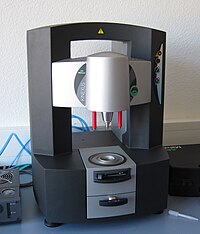
Photo from wikipedia
Stiff or semiflexible filaments can be cross-linked to form a network structure with unusual mechanical properties, if the cross-links at network junctions have the ability to dynamically break and re-form.… Click to show full abstract
Stiff or semiflexible filaments can be cross-linked to form a network structure with unusual mechanical properties, if the cross-links at network junctions have the ability to dynamically break and re-form. The characteristic rheology, arising from the competition of plasticity from the transient cross-links and nonlinear elasticity from the filament network, has been widely tested in experiments. Though the responses of a transient filament network under small deformations are relatively well understood by analyzing its linear viscoelasticity, a continuum theory adaptable for finite or large deformations is still absent. Here we develop a model for transient filament networks under arbitrary deformations, which is based on the cross-link dynamics and the macroscopic system tracking the continuously reshaping reference state. We apply the theory to explain the stress relaxation, the shape recovery after instant deformation, and the necking instability under a ramp deformation. We also examine the role of ...
Journal Title: Macromolecules
Year Published: 2018
Link to full text (if available)
Share on Social Media: Sign Up to like & get
recommendations!